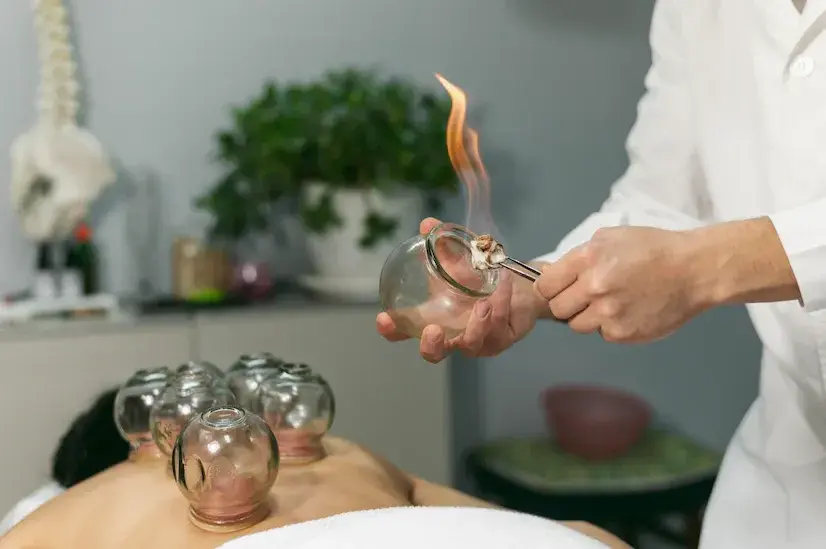Exercise Daily – Are you looking for a natural and effective way to alleviate pain and inflammation? Wet cupping, also known as hijama, has been used for centuries as a therapeutic practice. This ancient technique offers a range of benefits and is gaining popularity as a holistic approach to wellness. Let’s explore the fascinating world of wet cupping, its benefits, and how it can help you find relief from various ailments.
Wet cupping is an ancient healing technique that originated in traditional Chinese and Middle Eastern medicine. It involves creating suction on the skin by placing cups on specific points of the body. This suction draws out a small amount of blood, along with toxins and impurities, providing relief from pain and inflammation.

Benefits of Wet Cupping for Athletes
As athletes push their bodies to the limits, they often encounter various challenges, including injuries, muscle soreness, and fatigue. Wet cupping offers a natural and alternative approach to promote healing, improve recovery time, and enhance overall athletic performance.
Wet cupping involves placing cups on specific areas of the body, typically the back, to create a vacuum. This process draws out small amounts of blood, toxins, and stagnant fluids from the underlying tissues. The cups are usually left in place for a few minutes before being removed.
1. Improved Blood Circulation
One of the key benefits of wet cupping for athletes is improved blood circulation. By removing stagnant blood, cupping stimulates fresh blood flow to the treated areas, delivering vital oxygen and nutrients. This increased circulation aids in tissue repair, reduces inflammation and promotes faster healing of injuries.
2. Faster Recovery and Injury Rehabilitation
Athletes often face injuries or undergo intense training sessions that leave their muscles fatigued and prone to injury. Wet cupping can accelerate the recovery process by alleviating muscle soreness, reducing swelling, and promoting the regeneration of damaged tissues. It is commonly used as a complementary therapy alongside conventional rehabilitation methods.
3. Relief from Muscle Tension and Soreness
Intense physical activity can lead to muscle tension and soreness, affecting an athlete’s performance and overall well-being. Wet cupping provides relief from these symptoms by improving blood and energy flow within the muscles. It helps to release built-up tension, reduce pain, and restore optimal muscle function.
4. Enhanced Performance and Stamina
By promoting better blood circulation and relieving muscle tension, wet cupping can have a positive impact on an athlete’s performance and stamina. The improved delivery of oxygen and nutrients to the muscles allows athletes to train harder, recover faster, and sustain their peak performance for longer durations.
5. Detoxification and Stress Reduction
Athletes often experience high levels of physical and mental stress, which can hinder their performance and overall well-being. Wet cupping aids in detoxification by eliminating toxins and metabolic waste from the body, thereby reducing the burden on the liver and kidneys. Additionally, the relaxation and calming effect of cupping therapy help reduce stress, anxiety, and promote a sense of well-being.
6. Boosted Immune System
A strong immune system is crucial for athletes to maintain optimal health and avoid illnesses that can disrupt their training schedules. Wet cupping stimulates the immune system by improving lymphatic circulation and removing toxins. This helps athletes strengthen their immunity and reduce the risk of infections, allowing them to stay in top physical condition.
7. Psychological Benefits
Competitive sports can take a toll on an athlete’s mental well-being, leading to anxiety, pressure, and performance-related stress. Wet cupping offers psychological benefits by inducing relaxation, reducing anxiety, and promoting a sense of balance and calmness. Athletes often find cupping sessions to be rejuvenating and a valuable addition to their mental health routine.
8. Precautions and Safety Measures
While wet cupping can provide numerous benefits, it is important to take certain precautions and ensure the safety of athletes. It is advisable to seek professional guidance from a qualified and experienced cupping therapist who can perform the procedure correctly and address any concerns or contraindications.

How Wet Cupping Works
During a wet cupping session, a practitioner uses a small, heated cup to create a vacuum on the skin. The therapist then quickly removes the cup and uses a sterile lancet to make tiny incisions on the targeted area. Immediately, the therapist places the cup back on the skin, allowing the suction to draw out a small amount of blood. This process is repeated on various points of the body, depending on the individual’s condition and needs.

General Benefits of Wet Cupping
Wet cupping offers a range of benefits that contribute to overall health and well-being. Let’s explore some of the key advantages of this ancient practice.
1. Pain Relief through Wet Cupping
One of the primary benefits of wet cupping is its ability to alleviate pain. Firstly, the suction created by the cups helps increase blood flow to the affected area, promoting the release of endorphins, which are natural painkillers. This can provide relief from chronic pain conditions such as migraines, back pain, arthritis, and muscle soreness.
2. Reduction of Inflammation
Inflammation is a common underlying cause of many health issues. Wet cupping helps reduce inflammation by eliminating toxins and stimulating blood circulation. The process aids in removing stagnant blood and promoting the flow of fresh, oxygenated blood, which carries essential nutrients to the affected tissues, facilitating the healing process.
3. Improved Blood Circulation
Wet cupping enhances blood circulation, which is vital for maintaining optimal health. The suction created by the cups helps stimulate the blood vessels, improving their dilation and promoting better circulation. This increased blood flow can benefit various bodily functions, including nutrient delivery, toxin removal, and the overall efficiency of organ systems.
4. Detoxification of the Body
Toxins can accumulate in our bodies due to various factors such as environmental pollutants, poor diet, and stress. Wet cupping aids in detoxification by drawing out impurities and stagnant blood that contain toxins. This process helps cleanse the body, supporting the organs responsible for detoxification, such as the liver and kidneys.
5. Boosted Immune System
A strong immune system is crucial for fighting off illnesses and maintaining good health. Studies have found that wet cupping stimulates the production of white blood cells, which play a vital role in defending the body against infections and diseases. By boosting the immune system, wet cupping can help prevent and manage various health conditions.
6. Stress Reduction and Relaxation
Stress has become a prevalent issue in our modern lives, leading to various health problems. Wet cupping offers a therapeutic and relaxing experience, helping to alleviate stress and promote a sense of well-being. The gentle suction and release of tension during the procedure can induce a state of deep relaxation, allowing both the body and mind to unwind.
7. Wet Cupping for Skin Health
In addition to its internal benefits, wet cupping can also improve the health and appearance of the skin. By enhancing blood circulation, the procedure nourishes the skin cells, promotes collagen production, and helps in the removal of toxins. This can lead to a clearer, healthier complexion and a reduction in common skin issues such as acne and eczema.

Wet Cupping: A Safe Procedure
When a qualified and experienced practitioner performs wet cupping, it is considered a safe procedure with minimal risks. Ensuring that the cups and other equipment used are sterile and following proper hygiene practices is essential. Before undergoing wet cupping, it is advisable to consult with a healthcare professional, especially if you have any underlying medical conditions or are taking medication.
Finding a Qualified Practitioner
To experience the full benefits of wet cupping, it is crucial to find a qualified practitioner who is knowledgeable and experienced in this ancient technique. Seek recommendations from trusted sources, such as healthcare professionals or individuals who have undergone wet cupping themselves. Ensure that the practitioner follows strict hygiene protocols and uses sterile equipment to minimize the risk of infection.
What to Expect during a Wet Cupping Session
Before your wet cupping session, the practitioner will discuss your medical history, symptoms, and goals. The therapist will then identify the specific areas where they will place the cups. Patients generally tolerate the procedure well, experiencing mild discomfort or a sensation of pressure during the suction. The therapist typically leaves the cups in place for a few minutes before removing them. After the session, the practitioner will provide guidance on aftercare and any necessary precautions.
Aftercare and Recovery
Following a wet cupping session, it is essential to follow the aftercare instructions provided by your practitioner. This may include keeping the cupping areas clean, avoiding exposure to extreme temperatures, staying hydrated, and avoiding strenuous activities for a certain period. It is normal to experience some mild bruising or redness, which should resolve within a few days. If you have any concerns or experience unusual symptoms, consult your healthcare provider.
Dry Cupping vs Wet Cupping
What is Dry Cupping?
Dry cupping also referred to as dry suction cupping, involves placing cups on the skin to create a suction effect. In this therapy, practitioners use cups made of glass, silicone, or plastic. They create a vacuum by eliminating the air inside the cups, causing the skin to be drawn into the cup. This technique does not involve any incisions or bloodletting.
Wet Cupping: What is it?
Wet cupping, also known as medicinal bleeding or hijama, is a more invasive method compared to dry cupping. The therapist creates small incisions on the skin before placing the cups. After removing the cups, the therapist makes additional tiny incisions on the surface to allow controlled amounts of blood to flow out of the body. Wet cupping combines suction and controlled bleeding.

Techniques and Procedures
1. Dry Cupping Technique
During a dry cupping session, the therapist follows these steps:
- The skin is lubricated with oil or cream to allow the cups to glide smoothly.
- A flammable substance, such as alcohol-soaked cotton balls, is ignited briefly inside the cup to create a vacuum.
- The therapist quickly places the cup upside down on the skin, allowing the air inside to cool and create suction.
- The cups are left in place for a few minutes, and then they are removed by releasing the suction.
2. Wet Cupping Technique
Wet cupping involves the following steps:
- Similar to dry cupping, the therapist prepares and lubricates the skin.
- The therapist makes small incisions on the designated areas, typically superficial and painless.
- The therapist immediately places the cups on the incision sites, creating a suction effect.
- After a few minutes, the therapist removes the cups and uses a sterile disposable lancet to make small, controlled pricks on the surface of the skin.
- The therapist then reapplies the cups to the incision sites, allowing a controlled amount of blood to be drawn out.
- Once the therapist has extracted the desired amount of blood, they remove the cups and apply antiseptic ointment and bandages to the incision sites.
Benefits of Dry Cupping
Dry cupping offers several potential benefits, including:
- Pain relief: The suction created by the cups helps improve blood flow and relax muscles, providing relief from muscle and joint pain.
- Relaxation and stress reduction: Dry cupping promotes relaxation by stimulating the parasympathetic nervous system, which helps reduce stress and anxiety.
- Improved circulation: By enhancing blood circulation, dry cupping can aid in the delivery of oxygen and nutrients to tissues and facilitate waste removal.
- Detoxification: The suction effect of dry cupping may help draw out toxins and impurities from the body.
Benefits of Wet Cupping
Wet cupping provides additional benefits beyond those of dry cupping. They include:
- Bloodletting and detoxification: Wet cupping allows controlled bloodletting, which some practitioners believe can remove “harmful” blood and toxins from the body, potentially promoting overall wellness.
- Balancing the humors: In traditional medicine systems like Unani and Ayurveda, practitioners believe that wet cupping balances the humors in the body, restoring harmony and alleviating specific ailments.
- Anti-inflammatory effects: The controlled bleeding in wet cupping may help reduce inflammation and promote healing.
Safety and Considerations
1. Dry Cupping Safety
Dry cupping is generally considered safe when performed by trained professionals. However, some considerations include:
- Bruising and skin discoloration: The suction created by the cups can cause temporary bruising or discoloration of the skin, which typically resolves within a few days.
- Skin irritation: People with sensitive skin may experience temporary skin irritation or mild discomfort at the cupping sites.
- Infection risk: It is crucial to ensure that sterile cups and equipment are used to minimize the risk of infection.
2. Wet Cupping Safety
- Wet cupping carries additional risks due to the incisions and bloodletting involved. Some key considerations are:
- Infection risk: The incision sites need to be properly sterilized, and strict hygiene protocols must be followed to prevent infection.
- Bleeding and scarring: The small incisions made during wet cupping may lead to bleeding and scarring, although these are usually minor and heal over time.
- Individual suitability: Wet cupping may not be suitable for individuals with certain medical conditions, such as bleeding disorders, or those on blood-thinning medications.
How is Cupping Used for Health?
Cupping, a traditional method dating back to ancient times, now finds application in modern times as a complementary and alternative medicine technique for treating a wide range of conditions. Though cupping causes the skin to redden and leaves round bruises, it has shown promising results in increasing blood flow and improving the body’s ability to heal. During a cupping session, the therapist will place a flammable substance, such as alcohol-soaked cotton, inside a glass or silicone cup and set it on fire to create a vacuum.
Once the cup cools down, individuals place it on specific areas of the body, creating suction to draw blood and stimulate the lymphatic system. While there is anecdotal evidence suggesting that cupping may be effective, there is a need to conduct a systematic review of randomized controlled trials to validate its therapeutic benefits.
Additionally, ensuring strict sourcing guidelines and following sterile practices during cupping sessions is crucial to prevent infection and the transmission of bloodborne diseases such as hepatitis B and C. Overall, cupping’s potential to improve blood circulation and treat pain has garnered attention from both traditional healing practices and Western medicine, and further research from reputable academic research institutions and peer-reviewed studies is necessary to better understand its efficacy and safety profile.
Conclusion
Wet cupping, an ancient therapeutic practice, offers numerous benefits for pain relief, inflammation reduction, improved blood circulation, detoxification, immune system support, stress reduction, and skin health. When performed by a qualified practitioner, wet cupping can be a safe and effective natural remedy. However, it is essential to consult with a healthcare professional and find a reputable practitioner to ensure a positive and beneficial experience.
FAQs – Wet Cupping Benefits
Q: Is wet cupping painful?
Wet cupping can cause mild discomfort or a sensation of pressure during the suction process, but most people tolerate it well and do not consider it painful.
Q: How many wet cupping sessions are required to see results?
The number of sessions required varies depending on individual needs and the specific condition being addressed. Some people may see benefits after just one session, while others may need multiple sessions for optimal results.
Q: Can anyone undergo wet cupping?
While wet cupping is generally safe, it may not be suitable for everyone. It is important to consult with a healthcare professional, especially if you have underlying medical conditions, are taking medication, or are pregnant.
Q: Are there any side effects of wet cupping?
Mild bruising or redness at the cupping sites is common and usually resolves within a few days. Serious side effects are rare but can include infection or allergic reactions. Choosing a qualified practitioner and ensuring proper hygiene practices can minimize the risk of side effects.
Q: Can wet cupping be used alongside conventional medical treatments?
Wet cupping can complement conventional medical treatments, but it is essential to inform your healthcare provider about any complementary therapies you are considering. They can provide guidance on integrating wet cupping into your overall treatment plan.




